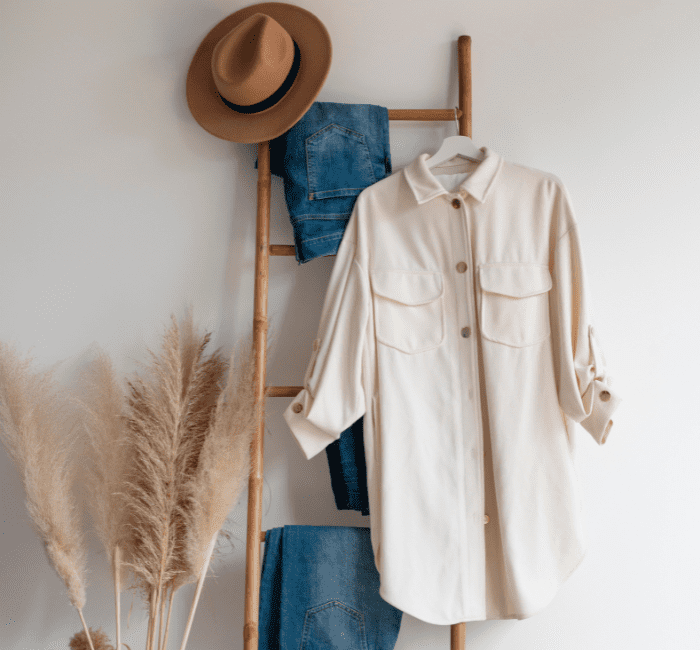The concept of a sustainable closet has gained immense popularity in recent years as the negative impact of fast fashion on the environment has come to light.
In this article, we will explore what building a more sustainable wardrobe entails and the reasons behind its growing importance.
We’ll cover everything from understanding how to create a sustainable wardrobe to finding and styling clothes from sustainable brands, providing practical tips and tricks along the way.
Eco-Friendly Fabrics 101

As conscious consumers seek to reduce their carbon footprint and minimize harm to the planet, eco-friendly fabrics are rising in popularity.
But what exactly are eco-friendly fabrics, and why are they so important for the environment?
This detailed guide takes a deep dive into the different “Types of Eco-Friendly Fabrics,” comparing and contrasting the benefits and drawbacks of utilizing natural fibers and upcycled apparel.
Natural Fibers and Recycled Materials
From organic cotton to wool, and beyond, natural fibers offer a more environmentally friendly alternative to synthetic materials like recycled polyester and nylon.
Although recycled polyester and nylon are useful, these fibers have their difficulties, such as higher costs and the potential for reduced durability. Some of these companies mass amount of so-called natural fabrics don’t pay fair wages to their workers.
Meanwhile, recycled materials offer a unique solution by repurposing post-consumer waste, yet still face the impact of producing new materials.
Comparing Natural and Synthetic Fabrics: Environmental Impact

The production of any fabric carries with it hidden costs to the environment, including water usage, chemical pollution, and greenhouse gas emissions.
It’s crucial to understand these impacts in order to make informed decisions when shopping for sustainable clothing.
The Hidden Cost of Fast Fashion: Understanding Fabric Impacts
The abundance of cheap, trendy clothing choices has a hidden cost: damage to the environment
From water usage to chemical pollution and greenhouse gas emissions, the production of different fabrics has a significant impact on our planet.
How to Make Informed Decisions
Many options available can make it difficult to choose eco-friendly fashion materials, making the process overwhelming. But it doesn’t have to be.
In this section, we offer practical tips and guidance on how to make informed decisions when selecting materials for your sustainable closet.
Explore the critical aspects to consider, including certifications, label examination, and questioning, to guarantee that your decision is the optimal choice for both yourself and the environment.
Building a Sustainable Wardrobe

While it may seem intimidating initially, developing a sustainable wardrobe can be a gratifying and empowering process with the correct steps.
Start by assessing the items in your current wardrobe and determine which ones you want to keep, donate, or sell.
Then, research sustainable and ethical brands and invest in high-quality, timeless pieces that align with your personal style.
Consider purchasing second-hand items and give them a new life.
Finally, take care of your new clothes by following proper washing, storage and care instructions.
Tips for Decluttering Your Current Wardrobe
Decluttering your current wardrobe is an important step in building a more sustainable wardrobe.
Begin by evaluating the items you currently own and determine which ones you actually wear and which ones you can part with.
Donate or sell the items that you no longer need, and recycle any items that are no longer wearable. This will not only make room for new, sustainable pieces, but also reduce excess waste in landfills.
Investing in Sustainable Fashion
Sustainable clothing brands may come with a higher price than fast fashion, but it’s essential to prioritize investing in high-quality, eco-friendly clothing for both your personal style and the environment’s sake.
Consider investing in environmentally conscious clothing brands that use eco-friendly materials and ethical production practices.
You can also purchase second-hand items to help reduce waste.
Creating a Capsule Wardrobe

A capsule wardrobe is a curated collection of versatile and timeless pieces that can be mixed and matched to create multiple outfits.
Building a capsule wardrobe allows you to focus on quality over quantity, reducing the amount of waste you generate.
To create a capsule wardrobe, emphasize buying clothes that fit your personal style and can be worn in different ways.
The Benefits of Having a Capsule Wardrobe
Having a capsule wardrobe has numerous benefits, including reducing waste, saving money, and simplifying your life.
A thoughtfully curated collection of versatile clothing can save you time and energy by reducing the stress of deciding what to wear.
Additionally, a capsule wardrobe allows you to make more conscious and sustainable closet choices, helping to protect the environment.
Ethical Fashion Brands Worth Investing In

As our world accelerates, making conscious choices towards supporting sustainable practices is becoming increasingly crucial.
In this section, we will talk about the thriving industry of organic materials and uncover the brands that stand out. From renowned companies to fresh and upcoming names, the possibilities are endless.
Established and Up-And-Coming Brands
Sustainable fashion has undergone a remarkable transformation in recent years, attracting the attention of even established fashion powerhouses.
Some of the most recognizable sustainable shopping brands include Patagonia, Eileen Fisher, and Levi’s – each with a long-standing history of responsible practices.
However, there’s also a growing group of emerging sustainable shopping brands worth exploring.
These brands often adopt a more niche approach to sustainability, delivering unique products.
How to Research Brands

As consumers become increasingly conscious of the impact their purchases have on the environment, researching sustainable and ethical brands has become a crucial aspect of responsible fashion choices.
But where to start?
To dive deeper into the practices of your favorite sustainable fashion brand, it is essential to delve into various sources of information.
Carefully examine their website, read through customer feedback, and don’t hesitate to communicate with the brand if you have any questions or concerns.
Additionally, it may be beneficial to examine the certifications that a brand holds, such as the Global Organic Textile Standard (GOTS) or Fair Trade Certified.
These certifications can offer valuable insight into a brand’s sustainability standards.
Assessing Sustainability Practices
When researching eco-friendly pieces, it is crucial to assess their sustainability practices in detail.
This encompasses evaluating the production process, materials used, labor practices, carbon footprint, and waste management policies.
Making Informed Purchasing Decisions
Ultimately, the aim of selecting a sustainable fashion brand is to make mindful and educated buying decisions.
Sustainability practices are not the only factor to consider when selecting a brand; the quality and durability of their products are equally significant.
By supporting sustainable fashion brands, you can contribute to a greener future, while also staying stylish and on-trend!
Second-hand Fashion: A Sustainable Solution

Second-hand clothing shopping is not just a budget-friendly option, but also a sustainable way to minimize waste and preserve the environment.
By buying pre-owned clothes, you are keeping them out of landfills, reducing demand for new production, and conserving resources.
Thrift Shopping for Environmentally-Friendly Waste Reduction
The fashion industry is among the most environmentally damaging industries, and buying second-hand clothes can aid in mitigating this impact.
By buying pre-owned clothes, you are reducing demand for new production and conserving resources.
Additionally, involving in second-hand shopping habits supports local communities and can provide a source of income for people in need.
Styling Sustainable Thrift Store Finds: Tips and Tricks
Shopping at consignment stores can be a smart choice, but it’s essential to understand the tactics for maximizing your money’s worth.
To start shopping for fashion items, research the most recent trends and make a list of the pieces you’re seeking. This can help you stay focused and avoid impulse purchases.
Additionally, you could also donate unwanted clothes when you start to build a sustainable wardrobe.
When you find an item you like, check for signs of wear and tear, such as holes, stains, or tears.
How to Assess the Quality of Clothes

Before buying second-hand clothes, it’s important to assess the quality of the item.
When inspecting an item, search for signs of damage like holes, stains, or tears and consider if it’s worth repairing or if it will only occupy space in your sustainable wardrobe.
Additionally, check the care label to see if the item is machine washable, as this can impact its longevity.
Incorporating Thrift Store Finds into Your Wardrobe
Once you’ve found some great second-hand clothes, it’s time to incorporate them in your closet for a more sustainable wardrobe.
Start by styling them with items you already own, and consider how you can mix and match them to create new outfits.
You can also think about how you can accessorize the item to make it unique to you. With a little creativity, you can make second-hand shopping a fun and sustainable part of your sustainable wardrobe building journey.
Conclusion
Sustainable fashion is now an essential aspect of our daily lives, profoundly impacting the planet and our collective well-being.
This guide emphasizes the critical importance of sustainable fashion and its benefits for both the environment and personal well-being. By prioritizing sustainability in our wardrobes, we can cultivate a more conscious approach to consumerism and invest in quality items that align with our values, ultimately contributing to a green future for our planet.
Sustainable fashion is not a passing trend but an urgent necessity, and it’s up to us as consumers to make informed purchasing decisions, educate ourselves and others, and advocate for environmentally responsible practices within sustainable brands.
There are many resources available, from books to websites and organizations, for those interested in expanding their knowledge and building a sustainable wardrobe for a more sustainable future.
Join the movement towards a greener future by investing in your own sustainable wardrobe and looking fabulous in the process.
FAQ
What is a sustainable wardrobe?
Sustainable clothing means clothing that is sustainable and durable. Buying less fast fashion will also mean focusing more on quality products that will last a lifetime.
What is the most sustainable wardrobe?
Secondhand clothing is the best way to create a sustainable wardrobe. This reduces new production of clothing while saving you money.
How can you make your wardrobe more sustainable?
Organize your wardrobe, donate clothes, choose clothes made of sustainable material, buy used clothing or vintage clothing.
What is the 30 wear rule?
The 30-Day Challenge involves an attempt to think about wearing the same clothing 30 times. It requires you to stop before clicking on purchase. If it’s not 100% yes, then no sale can happen.


